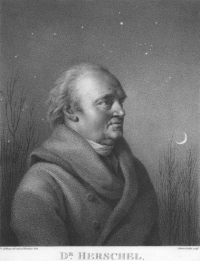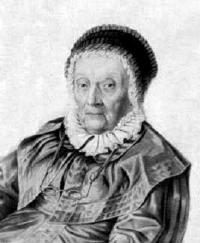William Herschel
 Biography
Biography
Sir William Herschel (1738-1822) | |
|
|
William Herschel was the son of a musician, born in Hanover in 1738. He followed in his father's marching footsteps, joining the Hanoverian guard as an oboist. With a Hanoverian King on the throne, Britain was really not very foreign at all, and Herschel moved to England to parlay his military musicianship into a teaching career in 1755, finally ending up among the gentry at Bath in 1766. He acquired an interest in astronomy, and started to build his own telescopes, developing and refining the reflector design first suggested by Newton to avoid problems with poor glass optics. Herschel cast and polished his own mirrors, producing ever bigger and better telescopes.
In 1772, he invited his sister Caroline to join him as an assistant in his musical business, and she duly moved to Bath. Both watched the skies. In 1781, William discovered the planet Uranus. For millennia, man had been aware of only six planets, five of them wandering the skies and visible with the naked eye. The discovery of a new planet (named by Herschel - albeit briefly - Georgium Sidus in honour of the then King) inspired Herschel to quit his career as a musician and teacher and concentrate full-time on astronomy. King George appointed William his private astronomer, and the Herschels moved to Slough, near the castle at Windsor.
By 1789, Herschel had built a forty-foot reflector, the largest telescope of its day, and he was scouring the sky. Caroline became an avid comet-watcher, and discovered eight comets in the years between 1786 and 1797. In 1787 she was granted a salary of £50 by the King to act as her brothers assistant.
Caroline worked hard on her own account too, publishing the "Index to Flamsteed's Observations of the Fixed Stars" and a list of his mistakes in 1797. After discovering several moons, Herschel turned his attention from the planets to the stars, and drew up a catalogue of double stars, which he showed were orbiting pairs. His paper "On the Construction of the Heavens," published in 1784, modelled the formation of the Milky Way, and marked the beginnings of Herschel's life-long interest in the in-depth cataloguing of the Universe.
Caroline Lucretia Herschel (1750-1848) | |
|
|
In 1800 Herschel described that the differently coloured filters through which he observed the Sun allowed different levels of heat to pass. He performed a simple experiment to study the "heating powers of coloured rays": he split the sunlight with a glass prism into its different constituent rainbow colours and measured the temperature of each colour. He observed an increase in temperature as he moved a thermometer from the violet to the red part of the 'rainbow'. Out of curiosity Herschel also measured temperatures in the region just beyond the red colour, where no light was visible, and to his surprise, he recorded the highest temperature there. He deduced the presence of invisible "calorific rays".
Over the rest of his life, he produced lists of thousands of nebulae and star clusters, the first to distinguish between distant clusters and dusty nebulae. After William's death in 1822, Caroline returned to Hanover and re-organised his catalogues into one extensive tome, for which she was awarded the Gold Medal of the Royal Astronomical Society - to which she was later elected a member - in 1828.
The Herschels' work marked the first time that a new planet had been discovered with a mechanical aid. But more than that, the Herschels' were pioneers of the systematic classification and investigation of the heavens. Gentleman scientist though he was, Herschel was one of the first "professional" astronomers, and his approach to his science was symbolic of a new style, following on from the experimental rationalism of Boyle and Newton.
Although the word had not yet been invented, the Herschels were amongst the first "scientists", as distinct from natural philosophers, concerned to enumerate in detail the "what's" as well as investigate the "why's". Victorian scientists became obsessed with classification and orderings of the world and the Herschels' work marked the early stages of that project.


